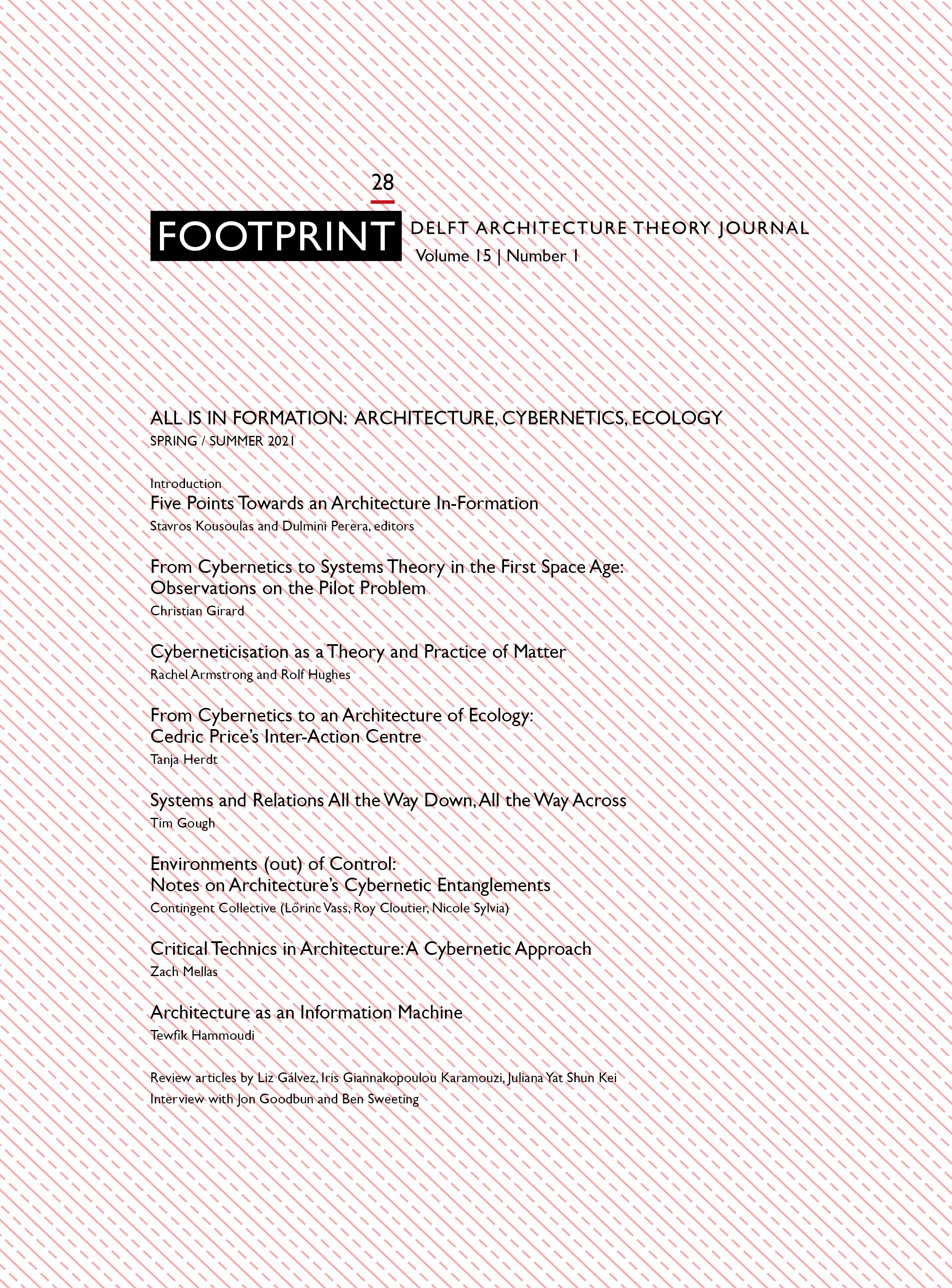‘What are people for?’
Ecologists and the Articulation of the Built Environment
DOI:
https://doi.org/10.7480/footprint.15.1.4824Abstract
This article revisits previously overlooked exchanges between pre-eminent figures in British architecture and ecology, William Holford, Julian Huxley, and Max Nicholson, which were incorporated in one of the earliest uses of the term ‘built environment’ in 1964. By examining how an energy-entropy interpretation of the ecosystem had shaped their views on the natural, human-made, and psychosocial milieu, I will consider the way cybernetics conditioned the articulation of the built environment. Contextualising their exchanges in the socio-cultural climate of the early 1960s, I trace an almost concurrent environmental turn made by architecture and ecology. Moreover, the exchange between architecture and ecology has engendered an environmental conception that prioritised the transformative and reciprocal relationship between humans and what surrounds them. In this effort, I pay particular attention to a co-evolutionary view of the technosphere, biosphere, and political sphere formulated by Nicholson. I also discuss the infiltration of eugenic and technocratic views in this reconceptualisation of the environment. Despite the peculiarities of these theories, their conceptualisation of the environment had pointed towards an important question in employing the ecosystemic metaphor: what are people for?
References
Allais, Lucia. “‘The Largest Stone in the World’, And Other Landmarks of Postwar Evolutionism” Paper presented in Society of Architectural Historian Conference 2020, Seattle, 30 April 2020.
Anker, Peder. Imperial Ecology: Environmental Order in the British Empire, 1895-1945. Cambridge, MA: Harvard University Press, 2001.
Anon. “Research into Problems of Planning and Construction: RIBA Statement.” RIBA Journal, March 1964.
Banham, Mary, and Devis Hillier. A Tonic to the Nation: Festival of Britain. London: Thames and Hudson, 1976.
Barry, Gerald. “The Festival of Britain.” Journal of the Royal Society of Arts 100, no. 4880 (August 1952): 667–704.
Bocking, Stephen. Ecologists and Environmental Politics A History of Contemporary Ecology. New Haven: Yale University Press, 1997.
Booker, Christopher. The Neophiliacs: Revolution in English Life in the Fifties and Sixties. London: Collins, 1969.
Cherry, Gordon. Holford: A Study in Architecture, Planning and Civic Design. Studies in History, Planning and Environment. London: Mansell, 1986.
Foucault, Michel. Security, Territory, Population: Lectures at the College de France. Edited by Arnold Davidson. Picador: New York, 2007.
Greenwood, Jeremy. “Nicholson, (Edward) Max.” In Oxford Dictionary of National Biography, 2007, Ill, Vol. ill. Oxford: Oxford University Press, 2007.
Hawkes, Dean. The Environmental Tradition: Studies in the Architecture of Environment. London: E & FN Spon, 1996.
Holford, William. “Shape and Environment.” Lecture. London: Goldsmiths College, 1963.
———. The Built Environment: Its Creation, Motivations and Control. Tavistock Pamphlet 11. London: Tavistock Institute, 1965.
Huxley, Julian. The Humanist Frame. New York: Harper & Brothers, 1961.
———. TVA, Adventure in Planning. London: The Architectural Press, 1943.
Leventhal, F.M. “‘A Tonic to the Nation’: The Festival of Britain, 1951.” Albion: A Quarterly Journal Concerned with British Studies 27, no. 3 (1995): 445–53.
Llewelyn-Davies, Richard. The Future of Environmental Studies. Edinburgh: The University of Edinburgh, 1967.
Martin, Reinhold. “Environment, c. 1973.” Grey Room 14, no. 2 (2004): 78–101.
McIntosh, Robert P. “Ecosystem Ecology, Systems Ecology, and Big Biology.” In The Background of Ecology: Concept and Theory, by Robert P. McIntosh. Cambridge: Cambridge University Press, 1985.
Nicholson, Max. Conservation and the next Renaissance. Berkeley: University of California, 1964.
———. How Britain’s Resources Are Mobilised. Oxford Pamphlets of World Affairs 30. Oxford: Clarendon Press, 1940.
———. The Environmental Revolution: A Guide for the New Masters of the World. London: Pelican Books, 1970.
———. The System: The Misgovernment of Modern Britain. London: Hodder and Stoughton, 1967.
Park, Robert E., Ernest W. Burgess, and Roderick D. McKenzie. The City. Chicago: University of Chicago Press, 1967.
Pruchnic, Jeff. Rhetoric and Ethics in the Cybernetic Age: The Transhuman Condition. London, New York: Routledge, 2013.
Schleper, Simone. “PERSPECTIVES AND POLITICS A Co-Evolutionary Reflection,” April 23, 2016. https://www.anthropocene-curriculum.org/contribution/perspectives-and-politics.
———. Planning for the Planet: Environmental Expertise and the International Union for Conservation of Nature and Natural Resources, 1960–1980. 16 vols. The Environment in History: International Perspectives. New York: Berghahn Books, 2019.
Sharr, Adam, and Stephen Thornton. Demolishing Whitehall: Leslie Martin, Harold Wilson and the Architecture of White Heat. London: Ashgate, 2013.
Downloads
Published
Issue
Section
License
Copyright (c) 2021 Yat Shun Kei

This work is licensed under a Creative Commons Attribution 4.0 International License.
- Authors retain copyright and grant the journal right of first publication with the work simultaneously licensed under a Creative Commons Attribution License that allows others to share the work with an acknowledgement of the work's authorship and initial publication in this journal.
- Authors are able to enter into separate, additional contractual arrangements for the non-exclusive distribution of the journal's published version of the work (e.g., post it to an institutional repository or publish it in a book), with an acknowledgement of its initial publication in this journal.





